Chimneys and flues: Don't forget the neighbours!
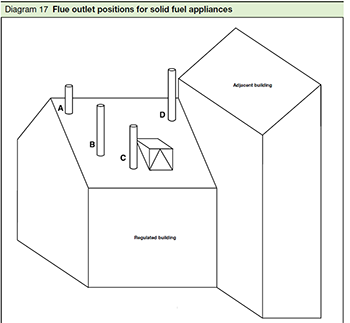
Approved Document J outlines the precautions needed to ensure that smoke and gases from appliances can be safely discharged. Diagrams 17 and 18 highlight the outlet heights needed in relation to traditional roofs and easily ignited coverings such as thatch and shingles.
In general, outlets need to be at least 600mm above the ridge where they are on or within 600mm of the ridge itself (A). If the flue or chimney is elsewhere its height needs to be lifted until the termination point is 2300mm from the roof covering when measured horizontally and at least 1000mm high or at least as high as the ridge (B).
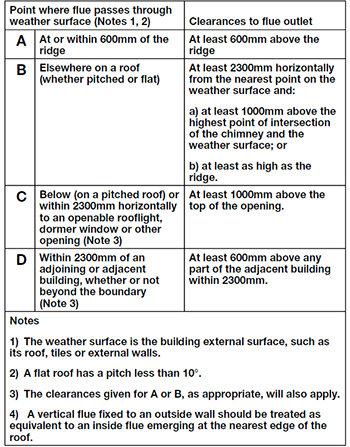
What have the neighbours to do with it..?
There are also requirements if there are other buildings within 2300mm of the ‘regulated building’.
So adjoining buildings less than a drive width away from the chimney also impose a requirement to raise the outlet at least 600mm above any part of the adjoining building (D).
This could cause problems on sloping sites or on infill developments with the chimney or flue needing to be higher than normal. Don’t forget that Approved Document A also places a structural requirement for chimney height to be no more than 4.5 times its width (2D1 and Diagram 20).
So the higher a chimney, the larger it needs to be. There is also a requirement (AD J 2.8) for flues to be at least 4.5m measured from the highest point of air entry – which could be the top of a fireplace opening. For bungalows this means that termination may be significantly higher than 600mm above the ridge.
Further information
Building Regulations Part J (Wales)
Guide to installing solid fuel stoves
Please Note: Every care was taken to ensure the information was correct at the time of publication. Any written guidance provided does not replace the user’s professional judgement. It is the responsibility of the dutyholder or person carrying out the work to ensure compliance with relevant building regulations or applicable technical standards.
This article was reviewed and updated on 10 August 2023
Sign up to the building bulletin newsletter
Over 48,000 construction professionals have already signed up for the LABC Building Bulletin.
Join them and receive useful tips, practical technical information and industry news by email once every 6 weeks.
Subscribe to the Building Bulletin
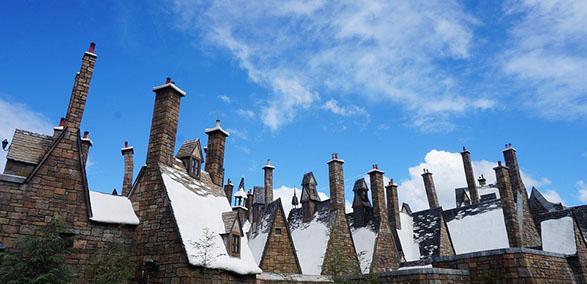
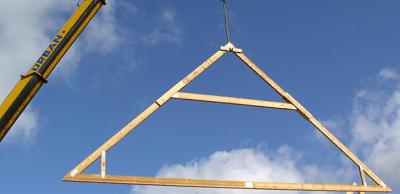
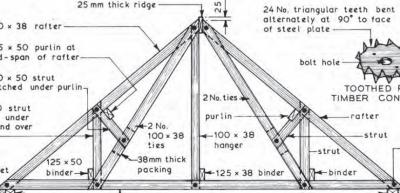

Comments
Chimney
Submitted 3 years ago
LABC response
Submitted 3 years ago
Thank you for your enquiry, LABC would not be able to provide specific advice on this matter and we would refer you to your local council’s Environmental Health team to consider in the first instance.
Best,
LABC team
Info needed on min height required for a commercial flue
Submitted 2 years 11 months ago
What are the regulations for the height of a flue when it is surrounded by residential properties,does the flue have to go above the ridge line of the highest property, which is also a listed building?
LABC response
Submitted 2 years 11 months ago
Thank you for your enquiry, the provision of a new flue is building work and should be provided for in a Building Regulation application to the Local Authority. There are a number of factors that will consider its technical performance and position in relation to the building in question as outlined in the building regulations, but it would not be possible to comment on a specific case and therefore I would suggest you make enquiries to your local authority for the particular details in this case.
Best,
LABC team
Shared chimney/party wall damage
Submitted 2 years 11 months ago
LABC response
Submitted 2 years 11 months ago
Thank you for your enquiry, if your property has experienced damage because of the work to your neighbour’s chimney then we would suggest the following actions.
• The damage is a civil matter and therefore it is something you would have to resolve with your neighbour and the civil law is covered under the party wall act. (https://www.gov.uk/government/publications/preventing-and-resolving-disputes-in-relation-to-party-walls/the-party-wall-etc-act-1996-explanatory-booklet)
• The repair to the shared flue will need to be sufficiently robust to ensure your fireplace is fit for purpose and that the neighbours log burner does not cause any issues in the flue or flue liner if one has been provided. The next-door neighbour should have had the log burner fitted by a registered competent person such as HETAS. (https://www.hetas.co.uk/) They in turn, would notify the local authority of the work. The duty of care for compliance sits with you neighbour and the contractor that they have employed, if you do not believe this has been resolved correctly then you should notify your LABC team of the issue.
Best,
LABC team
Shared Chimney/Party Wall
Submitted 2 years 11 months ago
The cottage I live in is 3 storey while the next door neighbours cottage is 2 storey.
We share a party wall.
Recently the property has been bought by a couple who plan to turn it into a holiday home. They also own a larger property on a new estate just recently built behind our row of cottages within walking distance.
As soon as they acquired the next door cottage, the new owners started gutting the whole inside back to the original stone brickwork.
This has resulted in the original fireplace being exposed which involves our party wall on the first floor. The separation between the 2 properties where the old fireplace stood is only one brick width.
The intention is to install a log burning stove. The chimney flue runs up our party wall to a chimney pot located on our roof one storey above their cottage.
This means they would have to access our roof to install a flue down to their lower floor to connect to their log burner.
The chimney pot is above our third storey bedroom located on the edge of our roof.
I am very concerned that the new owner will try to access the chimney without our permission.
I'm not keen on having strangers on our roof messing with the chimney or the smoke from a wood burning stove spewing out over my car parked outside our kitchen door on the lower level. We recentlythis year had all the front facing window surrounds sand blasted back to the original stone which are now a beautiful honey colour at considerable expense.
We have not been consulted on any of this building work concerning our adjoining party wall especially the matter of installing a log burning stove and the consequence of the flue running up all 3 floors of our property and the smell or damage from either smoke or heat radiating from the flue.
Any suggestions will be very helpful.
I'm 67 and my mom is 95.
The new owners seem pleasant enough and have eased my worry about the chisling out of the old fireplace which often seemed like it was coming through into our kitchen.
Should I contact the local council with my concerns.
Thank-you
LABC response
Submitted 2 years 10 months ago
Thank you for your enquiry, our website can only provide general advice regarding the requirements of the Building Regulations. There are several aspects in your comment that will relate to the Party Wall Act (this considers rights and obligations where building work is carried out by one owner but also affects the neighbouring owner and is civil law that your local council does not have the legal power to deal with). As work appears to be underway you should ask your neighbour to contact your LABC team to make an application for the alterations.
Best,
LABC team
Distance to Trees
Submitted 2 years 7 months ago
LABC response
Submitted 2 years 7 months ago
Thankyou for your enquiry, the Building Regulations, as outlined in the article, provide details in Approved document J in terms of the siting of flues and chimneys. You should refer to your manufacturers/installers details to ensure there are appropriate distances and separation from trees or shrubs in the vicinity of your wood burner.
Best regards,
LABC team
Ychwanegu sylw newydd